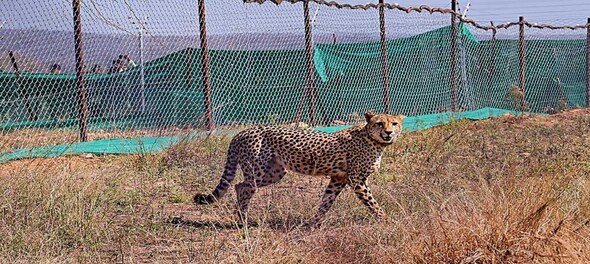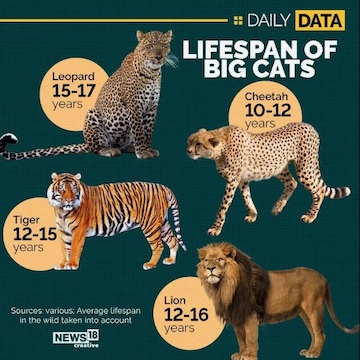
The death of eight cheetahs in four months has led to theories around "radio collars" being a possible reason for their deaths. Even though the government has refuted reports attributing the deaths to factors like radio collars, an Indian Express report cited wildlife authorities as suggesting the removal of radio collars from 10 free ranging cheetahs at Kuno National Park (KNP) in Madhya Pradesh.
"We are going to remove their radio collars... We can’t say how much time it would take to remove the collars of the free-ranging cheetahs, but we should ideally remove their collars and monitor them all. We are going to rigorously monitor this issue," officials were quoted by the report as saying.
A radio collar with an attached radio transmitter and GPS device is put on an animal so that its movements in its natural habitat can be remotely monitored.
Are radio collars deadly for cheetahs?
"The radio collar is not the fatal issue, (but) it can be a contributing factor and it must be addressed," J.S. Chauhan, Madhya Pradesh Principal Chief Conservator of Forests (Wildlife), told The Indian Express. He added that a bacterial infection may break out because of the radio collar in the monsoon.
"It may also be one of the reasons for the cheetah deaths," he said. He, however, batted for "a thorough examination to see if there are other causes."
Some claims about the possible radio collar effects
The chairman of the Cheetah Task Force said last week that Suraj, the three-year-old cheetah found dead in Madhya Pradesh on Friday (July 14), had died of septicaemia caused due to skin chafing by his radio collar. Suraj was translocated from South Africa to KNP in February this year.
Septicaemia refers to blood poisoning by bacteria, "which was a result of the radio collars worn around their necks in the prevailing wet conditions, " Vincent van der Merwe, a South African cheetah metapopulation expert, said.
Rajesh Gopal, the head of the cheetah project steering committee, also said that the reason for the cheetahs' death could be septicaemia from radio collar use. He said it is possible that aberrations like humid weather can lead to infection from radio collar use.
While terming the condition "highly unusual," he said, "The radio collar caused skin abrasion, which led to maggots infesting Suraj. His situation got aggravated due to wet and humid weather conditions, leading to the spread of high infection in his body and septicaemia, which is rarest of rare among cats."
"I have also seen it for the first time. It's a cause for concern and we have directed (MP forest staff) to check all the cheetahs," he added. Meanwhile, other experts, said only the post-mortem report will determine the exact cause.
'Hearsay without scientific evidence'
After the reports surfaced, the Environment Ministry said five out of the 20 adult cheetahs brought from Namibia and South Africa died due to natural causes. It added that the media reports attributing the deaths to factors like radio collars were based on "speculation and hearsay without scientific evidence."
The ministry said consultations are being conducted with international cheetah experts and veterinary doctors from South Africa and Namibia to investigate the cause of the cheetah deaths.
In a statement on Sunday (July 16), the ministry also said several steps have been planned to support the cheetah project, including the establishment of a cheetah research centre with facilities for rescue, rehabilitation, capacity building, and interpretation.
Eight cheetahs die in four months
Male cheetah Suraj, translocated from South Africa, died at the Kuno National Park in Sheopur on Friday, July 14. "This is for the first time that a cheetah died in the free range,” officials said. "There were injury marks on his back and neck, and a detailed report was awaited," they said.
Another translocated male cheetah, Tejas, had died at the park on Tuesday (July 11) last week.
Earlier, three cubs and three cheetahs had died in the span of two months. These three adult cheetahs included Sasha, a female cheetah who died on March 27 due to kidney complications. After her, male cheetah Uday died due to heart failure on April 24. On May 9, another female named Daksha died due to a fight with another male during mating.
The cubs"were malnourished from birth itself, while other deaths were from fights during mating or eating, which is common among animals", officials told PTI.

How common are deaths due to radio collars?
In 2020, wildlife experts blamed radio collars for the death of one of four Asiatic lions in Gujarat in a year. According to a Times of India report, 19 of the 89 lions, which were fitted with radio collars, had died in a year. This includes 14 lions that were fitted the tracking device in July 2019, the report said.
However, it cited wildlife experts working in the Gir forest saying that the number of deaths of radio-collared lions could be higher.
The report had also quoted experts saying that carrying around the radio collars, which weigh 1.5 kg, can be both uncomfortable and fatal for the lions.
Even then, few official had called the claims "baseless."
The cheetah translocation project
Eight Namibian cheetahs — five female and three male — were released into enclosures at KNP on September 17 last year at a high-profile event attended by PM Modi. In February this year, 12 more cheetahs arrived at KNP from South Africa.
The birth of four cubs had taken the total count of cheetahs to 24, but eight deaths have brought it down to 16.
Currently, 11 cheetahs are in free-range conditions, while five, including a cub born in India, are within a quarantine enclosure.
The causes of mortality can include intraspecific fights, diseases, accidents before and after release, injuries during hunting, poaching, road accidents, poisoning, and attacks by other predators.
Each free-ranging cheetah is closely monitored by a dedicated team. The ministry said the reintroduction of cheetahs is a significant project that is expected to face challenges.
It cited global experience, particularly from South Africa, where initial reintroductions resulted in over 50 percent mortality among introduced cheetahs.
The action plan for the cheetah project includes provisions for annual supplementation of the initial founder population to manage the demographic and genetic composition of the reintroduced population.
(Edited by : Shoma Bhattacharjee)
Check out our in-depth Market Coverage, Business News & get real-time Stock Market Updates on CNBC-TV18. Also, Watch our channels CNBC-TV18, CNBC Awaaz and CNBC Bajar Live on-the-go!


2024 Lok Sabha Elections | What does a low voter turnout indicate for NDA and I.N.D.I.A Bloc
Apr 29, 2024 5:48 AM
'Borrowed' leaders: Congress hits out at AAP for not fielding their own candidates in Punjab
Apr 28, 2024 9:53 PM
EC asks AAP to modify election campaign song and Kejriwal's party is miffed
Apr 28, 2024 9:25 PM

